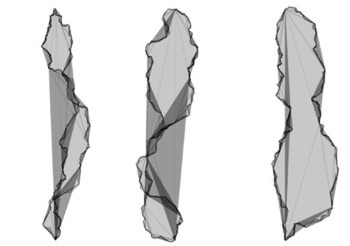| |
 |
|
 |
The animated sketch above uses three pairs of subdividing lines to
continually generate unique forms. There is no user interaction.
Intricate organic forms can be generated using recursively subdividing
lines. By randomly offsetting the midpoint of each subdivision, an
irregular overlapping line construct is produced.
|
 |
| |

figure
each stage of the subdividing process calculates a randomly
offset midpoint and repeats the process with the new segments
|
 |
The key to the construction process is
the definition of the subdividing line. In this example, the
line is initially defined by two endpoints, a color, and a depth.
The depth is used as a indicator of complexity. Because the
subdividing line instantiates other subdividing lines, a measure
of depth is required to keep the construct from becoming too
complex. The line creates one object of its own, the midpoint. |
|
|
| |
The subdividing process is fairly simple. For any given line, a midpoint
is calculated and randomly offset. Two new lines are then created
using the original endpoints and the new midpoint. Each new line is
assigned a depth value, indicating the number of times it has been
divided. Once a particular limiting depth has been reached, the line
stops dividing. The form is then complete.
|
|
| |

figure
three distinct recursively subdivided forms
|
|
| |
The graphic composition of these self dividing
forms is controlled using an increasingly opaque line, a nearly transparent
fill, and a color transformation revolving around a fixed blue component.
Since the subdividing line is merely an extension of the line, there
are many possible generative expansions. The pixie like figures seen
in the image below were generated using only three subdividing lines
each. Their sweeping movements were created by modifing the drawn
line into a curve approximating the direction of subdivision.
|
|
 |
| |
figure
dancing pixies composed initially
of only twelve subdividing lines
|
|
| |
This project was inspired by the countless implementations of subdivision
in fractal landform generation. |
|
| |
jtarbell, September 2002 |
|


